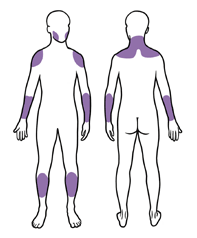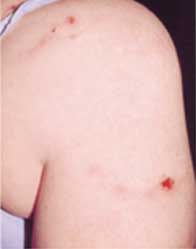
Am Fam Physician. 2001;64(12):1981-1985
See patient information handout on neurotic excoriations, written by the authors of this article.
Neurotic excoriations are self-inflicted skin lesions produced by repetitive scratching. Because there is no known physical problem of the skin, this is a physical manifestation of an emotional problem. The classic lesions are characterized by clean, linear erosions, scabs and scars that can be hypopigmented or hyperpigmented. The lesions are usually similar in size and shape, and are grouped on easily accessible and exposed body sites, such as extensor surfaces of the extremities, face and upper back. Psychotropic medications and appropriate counseling can be effective treatments.
Neurotic excoriations are skin lesions produced by the patient through repetitive scratching, without an underlying physical pathology. The patient often has a comorbid mental illness (usually anxiety or a mood disorder).1–3 Unlike other self-inflicted dermatoses (e.g., dermatitis artefacta and malingering), the patient with neurotic excoriations acknowledges the self-inflicted nature of the lesions. The quantity of lesions varies, ranging from a few to several hundred, and the lesions are located in easily accessible places on the body.4
Although it has not been reported in the primary care literature, the incidence and prevalence of neurotic excoriations is thought to be common and underreported. There is a 2 percent incidence of neurotic excoriations among dermatology clinic patients5 and a 9 percent prevalence of neurotic excoriations in patients with pruritus.6 The condition primarily affects female patients (52 to 92 percent in various studies).1,7,8 Most studies1,7 report a mean onset between ages 30 and 45 years.
Dermatologic Features
Neurotic excoriations are characterized as clean, linear erosions, scabs and scars that are frequently hypopigmented or hyperpigmented. All lesions are usually of similar size and shape. Patients “dig”at their skin to relieve itching or to extract imaginary objects that they believe are imbedded or extruding from their skin. The lesions are grouped at sites of the body that are easily accessible and usually exposed, such as the extensor surfaces of the extremities, face and upper back (Figure 1). The excoriations present in various stages: dug-out ulcers, ulcers covered with crusts and surrounded by erythema, and areas receding into depressed scars9 (Figure 2). The number of excoriations can vary from a few to several hundred, and they often exhibit delayed healing because of recurrent picking.

Differential Diagnosis
A patient's history may suggest some obvious reasons for itching, such as atopic dermatitis, contact dermatitis or food allergies. The following tests should be performed to eliminate any medical causes of generalized itching: complete blood count with differential chemistry profile, determination of thyroid-stimulating hormone levels and fasting plasma glucose level. The appropriate work-up for malignancy should be performed if indicated by the patient's history.
Xerosis, or generalized dry, flaky skin, is the most common cause of pruritus in the elderly population.12 The elderly lack fatty acids in the skin that augment hydration and barrier function, leading to the development of xerosis. The generalized itching that results can lead to anxiety or depression, and, subsequently, progression to neurotic excoriations.

| Hepatic disease |
| Pregnancy |
| Uremia |
| Delirium |
| Polycythemia vera |
| Hypothyroidism |
| Hyperthyroidism |
| Urticaria |
| Malignant lymphoma |
| Other malignancies |
| Carcinoid |
| Myeloma |
| Diabetes mellitus |
| Iron deficiency anemia |
| Xerosis |
| Intestinal parasitosis |
Depression, anxiety and obsessive-compulsive disorder (OCD) are the psychiatric diagnoses most commonly associated with patients who have neurotic excoriations. Another frequent association in these patients is many social stressors, particularly those related to family and work.2 Some of the psychiatric disorders and social stressors may be well hidden because of shame or a delusional belief system. Psychodynamic issues may center on suppression or repression of aggression relating to unmet emotional needs. These may arise from past or current situations and be difficult to resolve directly. Some associated traits include: low self confidence, generalized apprehension, meticulousness, depressive mood and hypersensitivity to perceived negativism toward themselves.13 Some physicians propose that certain cases of neurotic excoriations are actually a subtype of OCD.
Concurrent symptoms of headache or menstrual disorders are common in these patients. Usually the history, presentation and physical examination will quickly narrow the diagnostic choices.
Treatment Approaches
PHARMACOLOGIC
Several studies14–16 have shown that the serotonergic effect of selective serotonin reuptake inhibitors (SSRIs) consistently produces the strongest antipruritic response in patients with neurotic excoriations. These studies also found that the relief of pruritus was unrelated to changes in the patient's mood and occurred sooner than would be expected for antidepressant effects. This finding, combined with reports17 of a similar effect using the serotonin type 3 receptor antagonist ondansetron (Zofran), suggests that serotonin sites other than the 5-HT1a receptor may be key in the treatment of pruritus. There may also be an association with the reportedly effective treatment of neuropathic pain by SSRIs, implying a possible central, as well as peripheral, action on the pain/itch fibers.
OCD may be an underlying component in some cases, but the patient may deny or minimize it.6,10,18 Often, a lower dosage of an SSRI is required to lift symptoms of depression compared with improving symptoms of OCD. It is important to increase the dosages whenever lower dosages produce a partial response, initial response or nonresponse. If the patient is unresponsive to a specific SSRI, another SSRI should be tried, increasing the dosage by gradual increments.
The “itch-scratch” cycle induces mast cell degranulation and cytokines that may respond to antihistamines. Doxepin (Sinequan) is an antidepressant with antihistaminic properties. Doxepin is highly sedating—10 to 30 mg at bedtime is usually sufficient.
Other published reports15 support trials of tricyclic antidepressants, antihistamines and naloxone (Narcan) in some cases, but these agents have more side effects and less consistent efficacy.
A dermatologic approach to neurotic excoriations may include the use of antibiotics, topical steroids or lubricants:
If there is significant crusting and secondary bacterial infection of the erosions, antibiotic therapy (e.g., erythromycin or a first-generation cephalosporin) is indicated.
Steroids applied twice daily can be effective. Low-potency (group 5) topical steroids should be tried first, gradually progressing to high-potency steroids (group 1) if there is little or no response.9
Patients can also try substituting ritualistic application of lubricants for the ritual of dig-ging. It is helpful to recommend using only mild soaps and decreasing the frequency of washing.
Collaborative care is an important consideration, because many patients need active counseling in addition to medication.
COUNSELING
Initially, counseling should be supportive and empathic but open to other approaches as issues emerge. Cognitive-behavioral approaches may focus on helping the patient understand the illness through education and finding alternative responses to the pruritic sensations (i.e., changes in assumptions and automatic thoughts about the symptoms themselves, the substitution of a healthy ritual such as an oatmeal soak or distraction with other activities). The most difficult time for many patients is at night, when itching occurs while the patient is in the near-sleep state.
A close working relationship with a therapist will alert the physician to increasing stress in the patient's life that may present as new somatic concerns. The possibility of other psychiatric diagnoses emerging with therapy may also necessitate alterations in the treatment approach, including medications. Treatment aimed at a primary psychiatric diagnosis is usually fundamental for effective treatment of these patients.19
COMPLEMENTARY/ALTERNATIVE MEDICINE
| Depression |
| Anxiety |
| Obsessive-compulsive disorder |
| Somatoform disorders (facial dermatitis, somatization, hypochondriasis) |
| Delusions of parasitosis (may be part of a larger diagnostic group, such as schizophrenia) |
| Trichotillomania |
| Tic disorder |
| Body dysmorphic disorder |
| Borderline personality (self-mutilation) |
Role of the Family Physician
Researchers have shown that emotionally distressed Americans are more apt to seek help from a general physician than from a mental health professional.22 In the United States, primary care physicians diagnose and treat two thirds of patients with skin disorders.23 Neurotic excoriations are skin manifestations of an emotional problem requiring a biopsychosocial spiritual approach. The family physician is well equipped to help patients with this difficult problem.